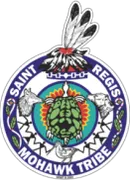AKWESASNE — The Saint Regis Mohawk Tribe’s Health Services Division has been awarded $1,104,214 from the U.S. Department of Health and Human Services (DHHS) to prevent and reduce suicidal behavior and substance abuse amongst Akwesasne youth. The Health Services Division will receive $998,589 over five years from the federal agency’s Substance Abuse and Mental Health Services Administration (SAMHSA) to support the Native Connections Program; while its Mental Health Department received $105,625 from the Indian Health Services (IHS) Division of Behavioral Health’s Office of Clinical and Preventive Services for a one-year Methamphetamine and Suicide Prevention Initiative (MSPI) – Generation Indigenous.
“Substance abuse and traumas, including generational and historical, continue to have serious repercussions in Akwesasne, particularly on youth suicides,” said Tribal Chief Beverly Cook on behalf of the Tribal Council. She added, “The Tribal Council realizes the urgency in dealing with contributing factors and have tasked tribal programs and other community providers in helping to prevent their devastating impact on our community, as one loss is too many.”
The Tribe’s Health Services Division and its Mental Health Department have been tasked to help spearhead work to reduce risk factors in the areas of suicidal behavior and substance abuse in collaboration with interested stakeholders; such as the Akwesasne Boys and Girls Club, Saint Regis Mohawk Tribe’s Alcohol and Chemical Dependency Outpatient and Prevention Programs, Akwesasne Suicide Prevention Coalition, Salmon River Central School District, and the Akwesanse Coalition for Community Empowerment—a drug and alcohol prevention coalition comprised of community members and services providers.
SAMHSA funding will support Health Service’s Native Connections Program, an initiative designed to reduce the impact of trauma and promote mental health among Akwesasne youth ages 24-years old and younger using culturally responsive models. It will enable the program to expand and improve its efforts to provide training, education, and information to community members about mental health and substance abuse, as well as suicide prevention, intervention and postvention. It will entail the development of a social media campaign to coordinate care services and provide information focused on youth needs to increase the likelihood of completing their educational paths.
“Our youth have quickly become the most vulnerable segment of our community for drug addiction and chemical dependency; which leads to higher rates of youth suicides, family dysfunctions, crimes and others abuses,” said Health Services Division Director Michael Cook. He noted, “During the past year, there have been several community and tribal meetings held to help address the crisis of youth accessing opioid and other prescription drugs, with three deaths in the first few months of 2016. Youth under the age of 24-years old represent a growing segment of our community’s population, currently 25 percent of our tribal membership, and as a result we are expanding our youth services to better respond to their growing need for help.”
At the same time, IHS’s Division of Behavioral Health’s Office of Clinical and Preventive Services awarded $105,625 to Health Service’s Mental Health Department for a Methamphetamine and Suicide Prevention Initiative. The funding will support implementation of early intervention strategies to help reduce risk factors for behavioral health disorders that contribute towards suicidal behavior. It will focus on the goal of promoting positive youth development by expanding outreach efforts to engage and screen youth for behavioral health issues in schools, head start, recreational and community service organizations, as well as through online screening tools. The funding from this grant will also provide an additional school based therapist in the Salmon River Central School District.
“Since July 2015, our Mental Health Department has treated 301 youth between the ages of 3-24, with our Alcohol and Chemical Dependency Program seeing 57 youth during the same time between the ages of 13-24 for substance abuse issues—and we know there are more youth in crisis,” said Mental Health Director Christine Venery. She noted, “Our youth need help now more than ever, as there have been 26 suicide attempts among our youth in the past 13 years, with at least nine young lives being lost to suicides and another 10 to substance abuse or drug-related accidents.”
To combat these statistics, the Health Services Division will hire additional behavioral health staff to further expand their screening efforts and provide school and community organizations improved coordination with their Mental Health Department. It will also be conducting a community needs assessment in cooperation with youth, families and providers to better determine needs for the effective implementation of preventive services. Some successful services they will be further exploring are recreational and cultural-based prevention activities in partnership with community organizations that are geared towards youth and families.
The grants are supporting the Saint Regis Mohawk Tribe’s efforts to make the provision of prevention and treatment services aimed at reducing substance abuse and youth suicides an ongoing priority.
#####
The Saint Regis Mohawk Tribal Council is the duly elected and federally recognized government of the Saint Regis Mohawk People.

